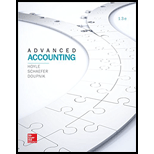
Soft Bound Version for Advanced Accounting 13th Edition
13th Edition
ISBN: 9781260110579
Author: Hoyle
Publisher: McGraw Hill Education
expand_more
expand_more
format_list_bulleted
Concept explainers
Question
Chapter 6, Problem 4P
To determine
Identify the appropriate answer for the given statement from the given choices.
Expert Solution & Answer
Want to see the full answer?
Check out a sample textbook solution
Students have asked these similar questions
Riverstone Publishers Inc. collects 80% of its sales on account in the month of the sale and 20% in the month following the sale. If sales on account are budgeted to be $450,000 for June and $380,000 for July, what are the budgeted cash receipts from sales on account for July?
Need help this question
Subject: financial accounting
Chapter 6 Solutions
Soft Bound Version for Advanced Accounting 13th Edition
Ch. 6 - Prob. 1QCh. 6 - Prob. 2QCh. 6 - When is a firm required to consolidate the...Ch. 6 - Prob. 4QCh. 6 - Prob. 5QCh. 6 - Prob. 6QCh. 6 - Prob. 7QCh. 6 - Prob. 8QCh. 6 - Prob. 9QCh. 6 - Prob. 10Q
Ch. 6 - Prob. 11QCh. 6 - How do noncontrolling interest balances affect the...Ch. 6 - Prob. 13QCh. 6 - Prob. 14QCh. 6 - Prob. 15QCh. 6 - Prob. 16QCh. 6 - Prob. 17QCh. 6 - Prob. 1PCh. 6 - Prob. 2PCh. 6 - Prob. 3PCh. 6 - Prob. 4PCh. 6 - Prob. 5PCh. 6 - Prob. 6PCh. 6 - Problems 7 and 8 are based on the following...Ch. 6 - Prob. 8PCh. 6 - Bens man Corporation is computing EPS. One of its...Ch. 6 - Prob. 10PCh. 6 - Prob. 11PCh. 6 - Prob. 12PCh. 6 - Prob. 13PCh. 6 - Prob. 14PCh. 6 - Prob. 15PCh. 6 - Prob. 16PCh. 6 - On January 1, Coldwater Company has a net book...Ch. 6 - Prob. 18PCh. 6 - Prob. 19PCh. 6 - Prob. 20PCh. 6 - On January 1, 2018, Stamford issues 10,000...Ch. 6 - On January 1, 2018, Stamford reacquires 8,000 of...Ch. 6 - Prob. 23PCh. 6 - Prob. 24PCh. 6 - On December 31, 2017. PanTech Company invests...Ch. 6 - Prob. 26PCh. 6 - Prob. 27PCh. 6 - Prob. 28PCh. 6 - Prob. 29PCh. 6 - Prob. 30PCh. 6 - Prob. 31PCh. 6 - Prob. 32PCh. 6 - Prob. 33PCh. 6 - Prob. 34PCh. 6 - Prob. 35PCh. 6 - Alford Company and its 80 percentowned subsidiary,...Ch. 6 - Prob. 37PCh. 6 - Prob. 38PCh. 6 - Prob. 39PCh. 6 - Prob. 40PCh. 6 - Prob. 41PCh. 6 - Prob. 42PCh. 6 - Prob. 43PCh. 6 - Prob. 44PCh. 6 - Fred, Inc., and Herman Corporation formed a...Ch. 6 - Prob. 46PCh. 6 - Prob. 47PCh. 6 - Prob. 48PCh. 6 - Prob. 49PCh. 6 - Prob. 50PCh. 6 - Prob. 1DYSCh. 6 - Prob. 2DYSCh. 6 - The FASB ASC Subtopic Variable Interest Entities...
Knowledge Booster
Learn more about
Need a deep-dive on the concept behind this application? Look no further. Learn more about this topic, accounting and related others by exploring similar questions and additional content below.Similar questions
- Hudson Textiles computes its predetermined overhead rate annually on the basis of direct labor hours. At the beginning of the year, it was estimated that 18,000 direct labor hours would be required for the period's estimated level of production. The company also estimated $88,000 of fixed manufacturing overhead expenses for the coming period and variable manufacturing overhead of $3 per direct labor hour. Hudson's actual manufacturing overhead for the year was $140,600 and its actual total direct labor was 19,000 hours. Compute the company's predetermined overhead rate for the year.arrow_forwardPlease help me solve this financial accounting problemarrow_forwardCan you help me solve this general accounting problem with the correct methodology?arrow_forward
- How much is Natasha's contribution margin ratio?arrow_forwardHello tutor please given General accounting question answer do fast and properly explain all answerarrow_forwardSuppose the required reserve ratio is 0.20 and individuals hold no cash. Total bank deposits are $150 million, and the banks hold $40 million in reserves. How much more money can the bank create if it does not hold excess reserves? Want Answerarrow_forward
arrow_back_ios
SEE MORE QUESTIONS
arrow_forward_ios
Recommended textbooks for you
 Auditing: A Risk Based-Approach (MindTap Course L...AccountingISBN:9781337619455Author:Karla M Johnstone, Audrey A. Gramling, Larry E. RittenbergPublisher:Cengage Learning
Auditing: A Risk Based-Approach (MindTap Course L...AccountingISBN:9781337619455Author:Karla M Johnstone, Audrey A. Gramling, Larry E. RittenbergPublisher:Cengage Learning

Auditing: A Risk Based-Approach (MindTap Course L...
Accounting
ISBN:9781337619455
Author:Karla M Johnstone, Audrey A. Gramling, Larry E. Rittenberg
Publisher:Cengage Learning